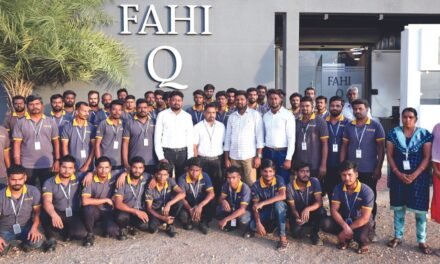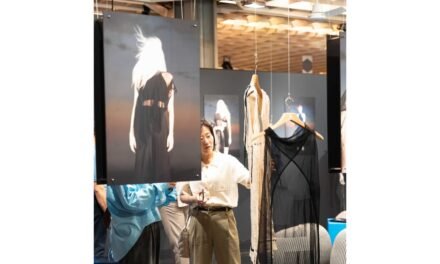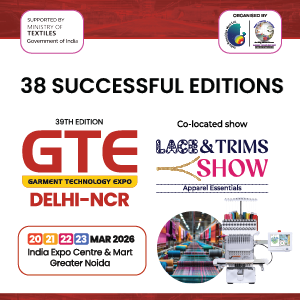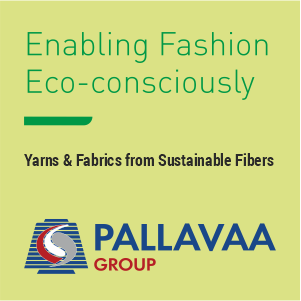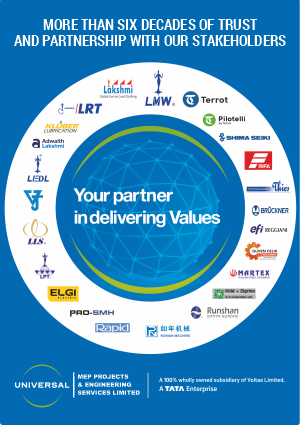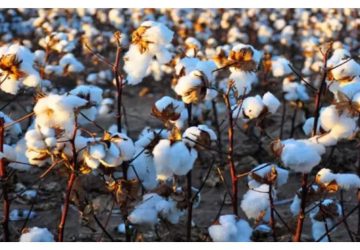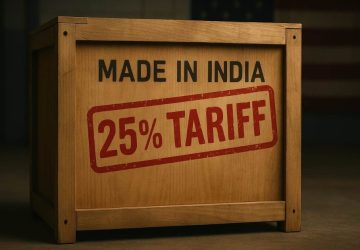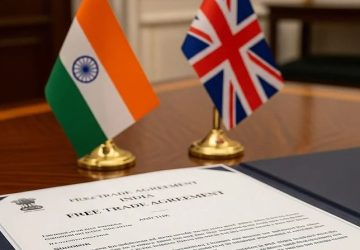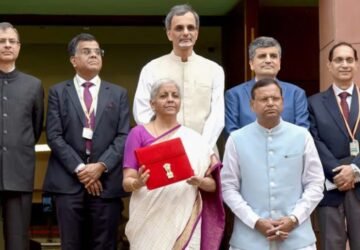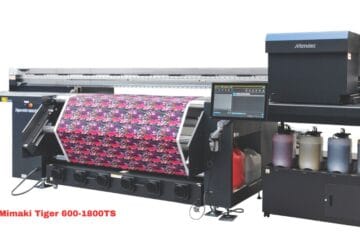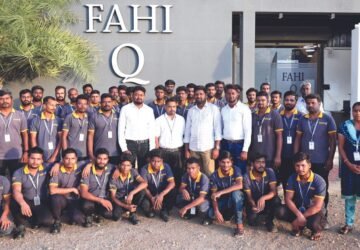
Raja M Shanmugham, MD of Warsaw International, recently took over as the new President of Tirupur Exporters’ Association (TEA) after Padmahri Dr. A Sakthivel stepped down as TEA President to leave way for youngsters in August. M Velusamy and KM Subramanian were elected as Vice-Presidents, and TR Vijayakumar as the new General Secretary. The change of guard was seen in the industry as the result of a group of younger and progressive entrepreneurs, who floated “Team for Change.” At this occasion, the Knitting Views’ editorial team interviewed Raja M Shanmugham to know about his plans after taking over as the President of TEA.
KNITTING VIEWS/SEPTEMBER-OCTOBER 2016 What would be your priority as the President of TEA to boost the exports from Tirupur?
My topmost priority to boost knitwear exports not only from Tirupur but across the country is to intensify our representation to the government and bring the ‘Knitwear Board’ stationed at Tirupur as a focused governmental agency to serve as a ‘growth engine’ for knitwear industry of the country.
There are already several ‘Boards’ for individual industry verticals, say, Coir Board, Coconut Board, Silk Board, etc. However, despite contributing significantly to the growth of export trade from the country, Tirupur is contributing around 46 per cent of country’s knitwear exports, despite the astounding opportunities available in the global marketplace to bring about a leap forward growth for knitwear exports from the country, the knitwear segment is lacking a similar focused governmental agency to address the needs of the industry so as to facilitate rapid growth. Hence, our top priority at this stage is to bring about the ‘Knitwear Board’ and make it the single point contact for the entire knitwear clusters across the country.
What are the various projects TEA has undertaken for the development of this industry?
Already the industry of Tirupur has embarked upon a ambitious project of increasing the textile industry turnover from the city from the present Rs. 35,000 cr levels to Rs. 1 lakh cr by the year 2020. These initiatives began a couple of years ago thanks to the visionary suggestion given by Hon’ble Prime Minister of India Narendra Modi. We have already prepared a DPR for this purpose listing out a host of measures to lift the industry performance to the desired levels. Few examples are as under:
• Extensive skill development programmes to create a pool of skilled labour to offset the shortage of skilled labour
• Encourage member units to adapt scientific process improvement methodologies such as Six Sigma, Lean manufacturing, etc.
• Creation of necessary industry infrastructure like Design Studio, Research Centre to handle the growing research needs of the business
• Empowering member units to go for product diversification into niche segments such as MMF textiles, technical textiles, etc.
• Liaison with government to synchronise GOI’s vision of building a house for every Indian and facilitate the building of 1 lakh housing units for labours
What other activities are you planning for export promotion?
Our immediate action plan is to streamline the affairs within our association and create a perpetual structure of independent committees for each of the verticals so that the growth of the industry is ensured through collective participation of all members.
What is your take on GST announced by the government recently? What are your demands from the government?
We welcome the government’s move to bring about a uniform PAN India Indirect Tax through the proposed GST Act. International experience has been that this reform actually encourages compliance and reduces leakages which are good for both the country and the industry alike.
However, our request from the government is to take note of the fact that textile industry is the second largest employment provider in the country next only to agriculture. Over 100 mn people are directly employed in this sector. We need to compete globally against intensive competition from neighbouring countries like Bangladesh, Vietnam while China continue to be the Monster holding a Lion’s share in the Global Textile Trade. In this scenario, we request that government to place the entire textile sector under the lowest possible slab of GST so that the industry can quickly get adapted facilitating smooth transition into the new levy.
What has been the impact of current economic slowdown in Europe on the Indian apparel exports?
European Union, being the biggest market for Tirupur industry, slowdown in the EU obviously has a negative impact on our trade. This is somewhat offset by some growth in the US markets. As a trade body, our plan is to encourage foray into newer markets like Africa, Latin America, Japan, etc., while concentrating on facilitating the exporters move up the value chain and enter the niche segments of textile trade that are registering rapid growth like technical textiles.
Why have the exporters not been able to gain much from the falling rupee?
While rupee has fallen vis-a-vis the dollar, the scenario with euro and GBP is entirely on the contrary. Besides, a similar fall in the currencies of our competing nations offsets whatever benefit that might accrue on account of rupee depreciation. Hence, our suggestion to members has been to look inwards and improve the manufacturing processes and efficiencies so as to save on cost –few test cases of lean implementation in Tirupur cluster proves that there is ample opportunity to do exactly that – rather than to look for profits through currency volatility which is always more a myth than reality.
What is the current market scenario in Tirupur? Where do we stand vis-a-vis Bangladesh?
As already stated, the slowdown in major economies does have a short term impact in the market scenario in Tirupur. As regards Bangladesh, it is a country enjoying MFN status and so many other benefits. However, Tirupur, as a universally acceptable, legally and socially compliant production hub is constantly registering decent growth despite these advantages enjoyed by our competitors. After the recent terror incidents in Bangladesh, Tirupur is viewed much more as a reliable partner in apparel manufacture than our competitors. Our task is to de-bottleneck our member units and build capacities so that we can meet the growing demands of the Western markets.
Shortage of skilled labour force has always been a major problem for Tirupur exporters. What is TEA doing to solve this issue?
Our NIFT-TEA institute is approved as an implementing agency under the Integrated Skill Development Scheme of the Textile Ministry and we have trained 1,00,00 labourers during the financial year 2015-16. More than 500 skilling centres have been established over the last 18 months not only in Tirupur but also in several far off places where labour availability is in plenty. We have plans to train 1 lakh labourers in the next couple of years so that the entire skilled labour shortage in Tirupur industry is totally wiped out.
Besides, we have also presented a revenue neutral funding strategy to the MSME Ministry to upskill the existing skill inventory so as to move towards ‘Zero Defect’ manufacturing process. We are expecting a favourable response from the government so as to make Tirupur the model ‘Zero Defect Apparel Cluster’ in the country.
What was our export performance for the first half of the year? Do you think we are going to achieve apparel export target of $50 bn for 2020?
As per the figures of Q1 of present fiscal, Tirupur has registered a robust growth as compared to the same quarter last year. Second quarter figures are being compiled and will be ready in a fortnight.
A concerted effort on the part of all the stakeholders including government, trade association and individual entrepreneurs is the need of the hour to achieve the desired targets. The government has also sent a positive signal by announcing a special package to triple the apparel exports from the country. Given the polarisation of apparel market in favour of India thanks to several international factors and also the positive outlook prevalent among the domestic manufacturers, we are very much confident of achieving the desired results by 2020.
What are the main challenges the exporters are facing here?
Skilled labour, production efficiency and wastages are the biggest challenges for Tirupur industry and detailed plans are afoot to handle these challenges effectively so that the industry can achieve the desired rapid growth momentum.
Do you feel that government policies are working in favour of exports? What steps do you think government should take for further development of this industry?
Government is taking very many proactive steps to boost exports, especially apparel exports. Special package announcement is one such biggest step in the right direction. Ease of doing business initiatives of the government are also being positively felt by the exporters. However, still many things to be done in this regard and under TEA, we are planning to constitute a special committee to look at the trade practices and represent to the government the specific steps to be taken to further ease the business environment in India.
In the last few months, we have experienced volatility in the price of cotton yarns. What is your suggestion to stabilize the cotton prices?
We, as a delegation, recently met the Hon’ble Union Textile Minister on this specific point. This issue needs to be handled with a long term vision through immediate/short term measures. This problem of huge multinational companies with piles of cash enter the cotton market and exit at their whim causing harm to the country’s economy needs to be addressed with stealth – where neither the farmers are benefited nor the industry which is left to be ruined. Of course, the free market argument has always been there but at the same time we give protection to agriculture and cotton textiles is nothing but an extension of agriculture and if textile industry is impacted, then the entire edifice right from agriculture to ultimate apparel will crumble, and it is a very serious issue.
Much more intensive brainstorming needs to be done both at the trade bodies as well as at the government level. Cotton Corporation of India needs to play a pivotal role not only in protecting the interest of the farmers but also the cotton consumers namely textile spinning industry that is presently under enormous stress. By all means, steps needs to be taken to protect the interests of farmers and the industry alike and prevent this flight of capital under the guise of a free market economy.
What is the present status of dyeing sector in Tirupur?
Dyeing sector in Tirupur has evolved a great deal over the last five years to become the only ‘Zero liquid discharge’ textile cluster across the globe. Though there are technical issues that crops up at times, overall, the dyeing industry is presently better off thanks to the stellar contributions from the government and the extensive efforts of the industry.
Do you think we are competent enough in terms of modern factories? What is your take on the present import duty structure on machinery and other raw materials?
Modernisation of factories is an ever ongoing and never ending process in the manufacturing sector. Issues regarding efficiency improvement, waste minimisation, etc., are always there which are only intended towards the goal of continuous improvement but thanks to the continued support of the Government of India through TUF Scheme, India has emerged as one of the most modern textile manufacturing hubs in the world.
How do you look forward to next one year for the Tirupur knitting industry and the Indian export industry?
We have our task sheet full with numerous initiatives to be taken in our march towards the `1 lakh turnover goal. Indian export industry is also poised for a good growth momentum thanks to several international factors including China becoming less competitive and the compliance issues and terror threats plaguing Bangladesh industry. Our agenda is to gear up and go with full force so as to make India the world leader in apparel manufacturing. And we intend to use the next one year in establishing structures within our association and perpetuate them through team spirit and national interest in our pursuit of achieving the above slated objectives.




